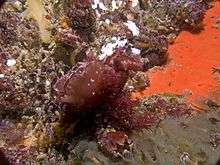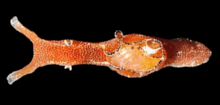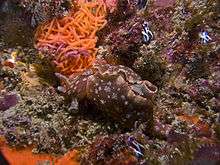Dwarf sea hare
| Dwarf sea hare | |
|---|---|
 | |
| Scientific classification | |
| Kingdom: | Animalia |
| Phylum: | Mollusca |
| Class: | Gastropoda |
| (unranked): | clade Heterobranchia clade Euthyneura clade Euopisthobranchia clade Aplysiomorpha |
| Superfamily: | Aplysioidea |
| Family: | Aplysiidae |
| Genus: | Aplysia |
| Species: | A. parvula |
| Binomial name | |
| Aplysia parvula | |
| Synonyms[2] | |
| |
The dwarf sea hare or pygmy sea hare, Aplysia parvula, is a species of sea slug, specifically a sea hare, a marine gastropod mollusc in the family Aplysiidae.[2]
Distribution
This is a circumtropical sea hare. The type locality of Aplysia parvula is Saint Vincent, Lesser Antilles.[1]
Description

The dwarf sea hare is round-bodied and smooth-skinned with a slender head bearing extensions which resemble rabbit ears. There are wing-like flaps (parapodia) extending from the body, which is brown to maroon or olive green in colour and may be covered with clusters of white spots.[3]
The maximum recorded length for this animal is 60 mm.[4]
Ecology

The minimum recorded depth for this species is 0.5 m; maximum recorded depth is 30 m.[4] It usually occurs in less than 5 m of water, but is occasionally found in water as deep as 24 m.[5]
The species is a herbivore, and feeds on different types of algae. Its egg mass is a tangled mass of sticky orange, green or brown strings found under rocks or among algae.[3]
References
- 1 2 Mørch O. A. (1863). "Contributions la faune malacologique des Antilles danoises". Journal de Conchyliologie 11: 21-43.
- 1 2 Rosenberg, G.; Gofas, S. (2012). Aplysia parvula Mørch, 1863. Accessed through: World Register of Marine Species at http://www.marinespecies.org/aphia.php?p=taxdetails&id=138757 on 2012-03-31
- 1 2 Gosliner T. M. (1987). Nudibranchs of Southern Africa ISBN 0-930118-13-8
- 1 2 Welch J. J. (2010). "The "Island Rule" and Deep-Sea Gastropods: Re-Examining the Evidence". PLoS ONE 5(1): e8776. doi:10.1371/journal.pone.0008776.
- ↑ Zsilavecz G. (2007). Nudibranchs of the Cape Peninsula and False Bay. ISBN 0-620-38054-3
- Bebbington A. (1977) Aplysiid species from Eastern Australia with notes on the Pacific Ocean Aplysiomorpha (Gastropoda, Opisthobranchia). Transactions of the Zoological Society of London 34: 87-147.
- Vine, P. (1986). Red Sea Invertebrates. Immel Publishing, London. 224 pp
- Gofas, S.; Le Renard, J.; Bouchet, P. (2001). Mollusca, in: Costello, M.J. et al. (Ed.) (2001). European register of marine species: a check-list of the marine species in Europe and a bibliography of guides to their identification. Collection Patrimoines Naturels, 50: pp. 180–213
- Branch, G.M. et al. (2002). Two Oceans. 5th impression. David Philip, Cate Town & Johannesburg.,
- Burn R. (2006) A checklist and bibliography of the Opisthobranchia (Mollusca: Gastropoda) of Victoria and the Bass Strait area, south-eastern Australia. Museum Victoria Science Reports 10:1–42
- Rosenberg, G., F. Moretzsohn, and E. F. García. 2009. Gastropoda (Mollusca) of the Gulf of Mexico, Pp. 579–699 in Felder, D.L. and D.K. Camp (eds.), Gulf of Mexico–Origins, Waters, and Biota. Biodiversity. Texas A&M Press, College Station, Texas.
External links
| Wikimedia Commons has media related to Aplysia parvula. |
- Rogers C. N., de Nys R. & Steinberg P. D. (2003). "Ecology of the sea hare Aplysia parvula (Opisthobranchia) in New South Wales, Australia". Molluscan Research 23(3): 185-198. doi:10.1071/MR03004, PDF.